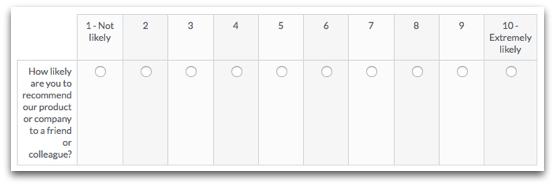Looking for a quick, reliable, and relatively easy way to find out what customers really think of your company? If so, it’s time to get comfortable with the Net Promoter Score. You’ve likely heard about this metric and the bevy of benefits it offers businesses. But what is the Net Promoter Score, and how can you get started with it today? Let’s take a look...
What is the Net Promoter Score?
The Net Promoter Score, or NPS, is centered around one simple question: How likely are you to recommend our product or company to a friend or colleague? That’s it! You may be skeptical that such a basic survey could yield meaningful results for your company, but more than a decade of use indicates otherwise. The article that first introduced the NPS concept to the world in 2003 is still revered as an authoritative resource in the business world. It’s been discussed at length in numerous best-selling books and is regularly used by leading companies ranging from Southwest Airlines to Amazon. Put simply, this metric allows a company to quickly and accurately determine where it stands in the eyes of consumers—and how far it has to go before loyal customers will begin to bring in new ones.
How is the NPS calculated?
A company can get its NPS by asking customers to rate their likelihood of recommending a product, service, or company to friends and colleagues:

Those who choose a rating of nine or 10 are considered “promoters.” These are the people who are actively encouraging others to use your product or service. Respondents who select six or lower are “detractors,” or the customers likely to dissuade others from doing business with you. Anyone who falls into the range of seven or eight is considered “passive.” Once you have enough responses, the results can be tallied using a straightforward Net Promoter Score calculation. To determine your official NPS score, simply take the percentage of promoters (the nines and tens) and subtract the percentage of detractors (sixes and lower). The number you get is your Net Promoter Score. Scores can range from -100, which means every single customer is a detractor, to +100, which indicates the opposite to be true. Generally speaking, you want to aim for a score above 0. By regularly measuring your NPS to gauge your performance over time, you can strive toward 50 and even inch your way closer to 100.
Why should you use the NPS system?
There are numerous areas where the Net Promoter Score can be helpful, but the bottom line is this: It’s insightful and easy. And in the world of survey research, that’s not a common thing to accomplish. For your customers, the NPS scoring is quick and painless. These one-question surveys are far less intrusive than many other methods for gathering customer feedback. There are no focus groups to attend or multi-page surveys to slog through. For your business, the NPS can be a reliable way to get an accurate read on how services are perceived and what needs to happen to ensure better customer experiences. In addition to measuring overall customer satisfaction, this metric can be used by staff when setting goals and identifying areas for improvement.
How to get started with NPS scores
If you’re just getting started with customer feedback and want to ease your way into NPS scoring, one option is to begin with the five-star rating system. Because most customers are already familiar with this system, it can be a good way to get comfortable with analyzing feedback for a few weeks before you transition to measuring your Net Promoter Score. Whether you start with ratings or go straight to the Net Promoter Score, a few essential tips will help ensure you’re getting the results you need:
- Automate the calculation of your NPS by using an advanced form builder or similar tool that allows you to see the results in real time.
- Choose the right frequency to encourage a high response rate. Give your customers enough time to get acquainted with your product or service before you hit them up with your survey, and then follow up at monthly or quarterly intervals.
- Monitor results regularly so you’ll know when there are significant changes up or down in the scoring spectrum.
- Respond quickly to any spikes or dips—whether that means following up with promoters for testimonials or communicating with detractors to learn how you can win back their affection.
The term “Net Promoter Score” may sound like a highly involved and complicated process, but in reality it’s one of the easiest—and best—ways to gauge where your company stands in the eyes of clients and customers.
Ready to get started with NPS today? Check out Formstack’s Net Promoter Score template or learn more about our customer survey solutions.












